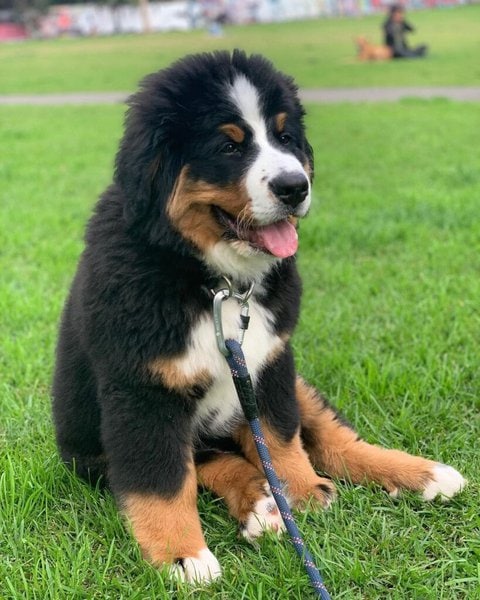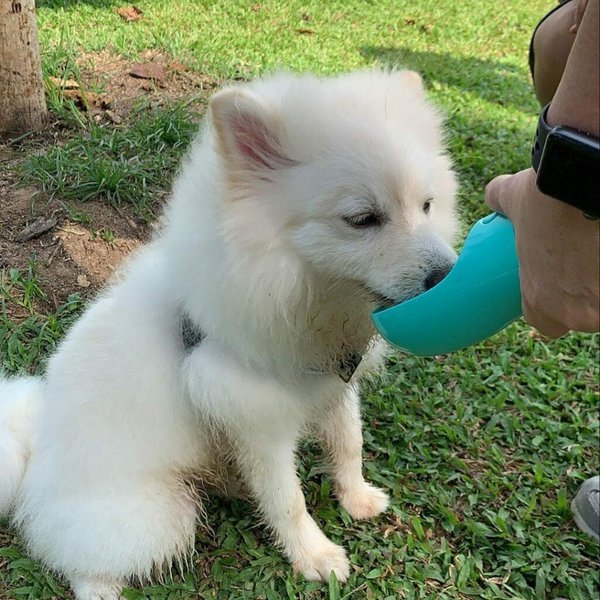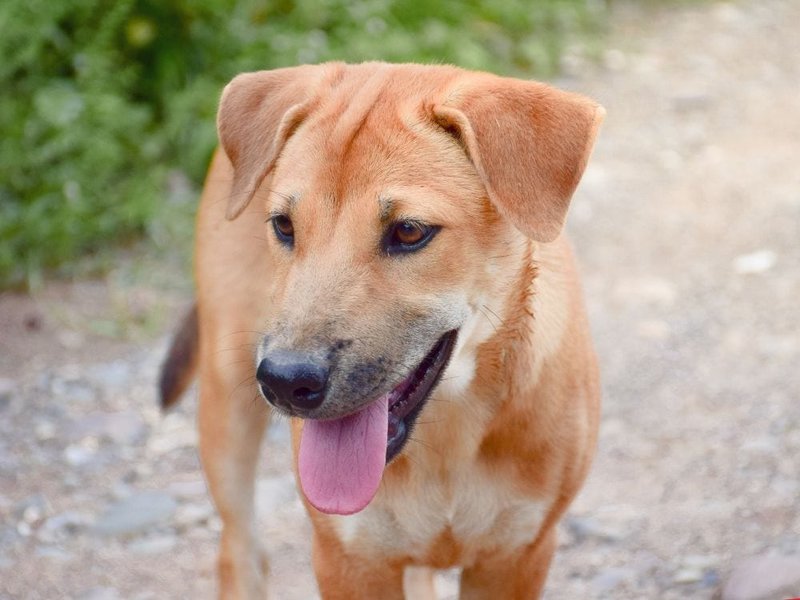Rapid breathing is one of the first observable signs that a puppy is in trouble; nobody likes to see their pup suffer and not have the faintest idea of why it happens or what to do. So, is it normal for a puppy to breathe fast?
Puppies typically breathe faster when they’re excited or sleeping, but fast breathing can also be a sign that your fido either is stressed, has over-exerted itself, or has a foreign object stuck in its throat. Also, rapid breathing in puppies can be a sign of health conditions such as bloat, obesity, and heart and lung diseases, among others.
Fast breathing or any form of breathing difficulty in a puppy shouldn’t be trifled with, and prompt action is key to guaranteeing the safety of your furry friend in these situations. The ability to recognize that your furry friend is having a hard time breathing is crucial to taking prompt action, and the common signs of respiratory distress are explained in this article. However, before we go further, let’s examine what it means to say a puppy is breathing too fast.
Is My Puppy Breathing Too Fast?
In general, a puppy is considered to be breathing too fast when its breathing rate increases to or exceeds 30 breaths per minute.
Determining whether or not your puppy is breathing too fast can’t be achieved without first establishing what the normal breathing rate should be.
Puppy dogs are typically expected to breathe at a rate of between 15 to 40 breaths per minute. While adult dogs, having mastered and developed their breathing pattern, normally breathe at a slower rate of between 10 to 30 breaths per minute.
However, for some reason or the other, your puppy’s breathing can be significantly higher than what is considered to be the acceptable rate, and this is down to a number of reasons.
Why Is My Puppy Breathing Too Fast?
Some of the factors commonly responsible for abnormally fast puppy breathing include:
High Temperatures
Puppies that have spent a considerable amount of time under unbearably hot weather conditions typically tend to breathe too fast, and this is in a bid to regulate their body temperatures.
Panting is a puppy’s natural alternative method of circulating cool air around its body when it is overheating. And generally, the faster the breathing, the hotter the puppy feels.
Overexertion
Puppies are big bundles of energy and will continue to run and play around as long as you allow them. And once your pup decides to take a break from all the running around, you can typically observe it breathing fast in a bid to calm its body down and catch its breath.
Stress
Most, if not all, puppies experience fear and anxiety when they’re separated from their mothers and when they arrive at their new homes. And this is when we typically have one of the most common instances where a puppy is found to be breathing too fast.
Additionally, puppies also tend to breathe too fast when they encounter other stressful situations, such as going on a car ride for the very first time or when they’re in the presence of a fear-inducing character or object.
Sleeping
Puppies also tend to breathe fast while sleeping, and this is largely due to a phenomenon known as the Rapid Eye Movement (REM) stage, a period in which sleeping puppies typically have vivid dreams.
During this REM stage, a puppy’s brain and body need a high supply of oxygen and energy, and the pooch will typically breathe faster to meet the demand.
Fortunately, most puppies will breathe faster while they’re asleep and return to normal once they’re awake; Hence, this is not something you need to worry about too much.
Medical Issues Responsible For Rapid Puppy Breathing
Similarly, your puppy breathing too fast can be due to an underlying medical condition, and some of the most common culprits include:
Brachycephalic Syndrome
The facial anatomy of some dogs is such that they have pushed-in faces with short snouts, and the implication of this is that such dogs typically have narrower airways.
Consequently, when such brachycephalic puppies over-exert themselves, especially during physical activities, they typically experience breathing difficulties, which leads to faster breathing in a bid to regulate their body functions.
Tachypnea
Tachypnea in puppies is a medical condition characterized by a faster rate of breathing, and it has several causes, some of which include:
- Nostril infections
- Windpipe diseases, such as swelling, collapse, and paralysis
- Diseases of the lung, such as cancer, clots, parasites, and pneumonia
- Abdominal diseases, like bloat
- Diabetes
- Obesity
- Heart diseases

How Do You Tell If A Puppy Is Having A Hard Time Breathing?
Common signs of respiratory distress in puppies include sudden or frequent sneezing, wheezing, belly contractions, a noticeable effort by the pooch to move its chest wall, and changes in the sound of the dog’s bark.
When everything is going fine, you shouldn’t be able to hear your puppy breathing. But in cases of respiratory distress, the pooch’s breaths typically become more audible and unusual.
High-pitched noises while breathing indicate an obstruction of the puppy’s upper respiratory airway, while frequent sneezing can mean that your pooch has ingested toxic foreign objects that are making breathing difficult.
You can also observe your puppy’s standing posture if you suspect that the pooch is having a hard time breathing. Puppies that are finding it difficult to breathe typically stand with their elbows stretched wide and their necks extended further than usual.
Additionally, dogs that are having a hard time breathing will make conscious, noticeable efforts to move their chest walls in a bid to circulate oxygen faster. And an inability to rest or lie down can also indicate that your puppy is finding it difficult to get enough oxygen into its body.
How To Determine Your Puppy’s Respiratory Rate?
Your puppy’s respiratory rate is best determined by watching and taking count of the pooch’s chest movement when it is fast asleep.
Before you set out to determine your puppy’s breathing rate, you should watch the pooch sleep for some minutes to familiarise yourself with its breathing. Once this is done, you can then proceed with the following steps:
- Set a timer to one minute and place it near the pooch.
- Within this minute, take note of the number of your sleeping puppy’s chest contractions. A single breath is completed with both the inflation and deflation of the puppy’s chest.
- If it is difficult to get continuous readings for one minute straight, you can terminate the timer at 30 seconds and multiply your value by 2 to get the puppy’s breath-per-minute (bpm) rate.
- Similarly, you can observe your puppy breathing for 15 seconds, and multiply the obtained value by 4, to obtain the pooch’s bpm rate.
Also, to get a better idea of your puppy’s breathing rate, it is recommended that you perform the above test repeatedly and compute the average of the rates you get on each occasion.
Once you are able to successfully determine your puppy’s respiratory rate, you should proceed to use this vital piece of info to judge when your pooch’s breathing is either too fast or slow.

What Do I Do If My Puppy Is Having Trouble Breathing?
The first thing to do when you notice that your puppy is having trouble breathing is to call a vet and explain the symptoms you’re observing. Or, try calming a stressed puppy and shielding your puppy from extremely hot weather conditions to regulate its breathing.
Consulting Your Vet
Breathing difficulty can be a sign of a health issue requiring urgent medical attention; Hence, when you observe your puppy having trouble breathing, along with additional symptoms such as lethargy, diarrhea, and coughing, the responsible thing to do is reach out to your vet for help.
Traveling To The Hospital
If it is decided that your puppy will need to be present at the vet hospital, you should make preparations to make the pooch as comfortable as possible during transportation to avoid aggravating symptoms.
Generally, things you’ll need to do to keep your puppy comfortable while transporting it to the hospital include:
- Prepare a special pet carrier.
- Pad the carrier with soft clothing material for comfort, and encourage the puppy to lie down.
- Avoid handling the puppy unnecessarily and minimize movement.
- Drive carefully.
What Happens At The Hospital?
Upon arriving at the hospital, the vet will carry out a comprehensive medical examination to determine where your puppy’s breathing difficulties stem from. The tests involved in the medical examination typically include fecal testing, urinalysis, blood work, physical examinations, and X-rays, among others.
If a foreign object is found to be obstructing your puppy’s airway, thereby leading to faster than normal breathing, a surgical procedure may be needed to get rid of this object.
Similarly, your vet may also prescribe the use of intravenous fluids, certain medications, and pain relief drugs to help treat the underlying illness and restore your puppy’s breathing to normal.
Calming Your Puppy
Understandably, attempting to calm a panicky puppy during stressful situations is easier said than done, but you can shower your pooch with love and be extra gentle with the young fido during this troubling period.
Treats can come in handy at calming stressed puppies, and special doggie products such as the Thundershirt Classic Dog Anxiety Jacket have also proven to be effective at reducing anxiety in dogs.
When wrapped around your puppy, the Thundershirt Jacket applies gentle pressure that has a calming effect on the pooch, thereby reducing anxiety and helping to regulate the dog’s breathing.
If your puppy has repeated episodes of fast breathing due to stress, we recommend that you employ the services of a professional dog behaviorist to help teach your pooch how to manage its anxiety.
Keeping Your Puppy Cool
If excessive heat is determined to be responsible for your puppy’s rapid breathing, then the immediate remedy is to take the pooch indoors and try to make the home temperature cooler. This can be achieved with the aid of an air conditioner and by providing sufficient cold water for the puppy to cool its body.
Failure to cool your puppy down as soon as possible can lead to heatstroke, which can be fatal for the pooch.






